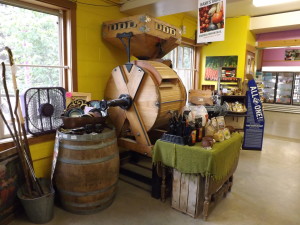About six years ago, Farmer Nash was at the Blue Heron Bakery near Olympia, WA, chatting with the owner about milling wheat, something Nash wanted to start doing to create a value-added product from the wheat the farm was growing. The bakery owner mentioned he had an old mill he would like to sell, and Nash bought it.
While no one can find a make, model, brand or year of manufacture on the mill, we know it was built on the East Coast, because the original housing was Eastern White Maple. It was not in good condition, so Sam McCullough, Colten Bartlett and Dave Roberts took it on as a “winter project,” something they could do in the warm, dry shop. They disassembled the entire thing, and worked on cleaning up the parts, replacing some of them, and, with the help of Edensaw Lumber in Port Townsend, matched the wood piece by piece. They repaired water damage, sanded and varnished the wood, and then painstakingly reassembled it.
Nash took the Missouri Sandstone millstones to a grain conference in Mount Vernon, where Roger Jensen, an expert on calibrating millstones, looked them over and pronounced them fit to start milling without further work. The stones sit vertically in the housing. One is stationary, and the other turns. Wooden mills constantly flex, and the drum is not nailed, but clamped, so the miller can respond by tightening one clamp or loosening the opposing clamp. The moving stone can also be moved closer for a finer grind. This made for tedious work, and try as we might, we could never efficiently do really fine flour without burning some of the grain.
Consequently, when the Bell Street Bakery in Sequim closed, Nash purchased their modern metal mill and sifter. It is many times more efficient and does not need the constant calibration to mill fine flour. But the old mill has a new job—it is an excellent display background for our grains, flours, and corn meal in Nash’s Farm Store.

